Santa Cruz Bullit 4
Wheel Sizes: 29’’ front / 27.5’’ rear
Suspension Travel:
- Frame: 170 mm
- Fork: 170 mm
Geometry Highlights:
- Sizes offered: S, M, L, XL, XXL
- Headtube angle: 63.6° (High), 63.3° (Low)
- Reach (size Large): 480 mm (High), 477 mm (Low)
- Chainstay length (size Large): 446 mm (High), 447 mm (Low)
Drive System Highlights:
- Motor: Bosch Performance Line CX
- Torque: 85 Nm
- Power: 600 W
- Battery: Bosch PowerTube 600 (600 Wh)
- Display: Bosch System Controller
- Remote: Bosch Mini Remote
Frame Material: Carbon fiber; C or CC grades
Price: Complete bikes from $7,399 to $11,899 USD / $9,649 to $15,549 CAD
Blister’s Measured Weight (Santa Cruz Bullit, size Large): 47.83 lbs / 21.69 kg
Test Locations: Colorado, New Mexico
Reviewer: Simon Stewart (6′, 170 lbs / 183 cm, 77.1 kg)
Test Duration: 4 months
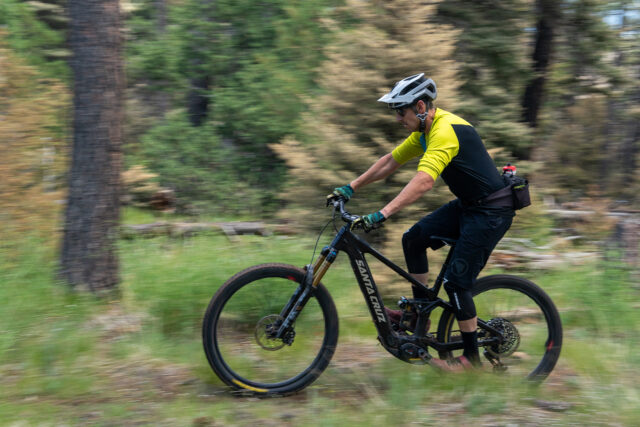
Intro
Santa Cruz surprised a lot of folks when it did away with VPP on the Vala, and now they’ve done it again with the fourth-generation Bullit. Despite looking a whole lot like the Vala, the Bullit kicks things up a notch, with 170 mm of travel front and rear mated to Bosch’s latest CX motor. We just got one in for review and will have a Flash Review up very shortly, but in the meantime, join us to walk through the details of Santa Cruz’s burliest eMTB, the Bullit.
The Frame
Santa Cruz has long maintained similar design language across most of the various bikes in its non-motorized lineup, and they’re going down that same path with their new eMTB lineup, too. The Bullit shares its aesthetics with the Vala (Full Review coming very soon), driven by the Vala’s new-for-Santa-Cruz Horst link suspension layout that allows them to get around some of the limitations of building an eMTB around the VPP design seen on the bulk of their non-motorized bikes.
While Santa Cruz doesn’t publish the new Bullit’s suspension kinematics, it seems likely that they are generally similar to what was achieved with the Vala (those graphs are in our First Look here) in their smoother, flatter anti-squat and anti-rise curves relative to their prior VPP-equipped eMTBs like the last generation Bullit.
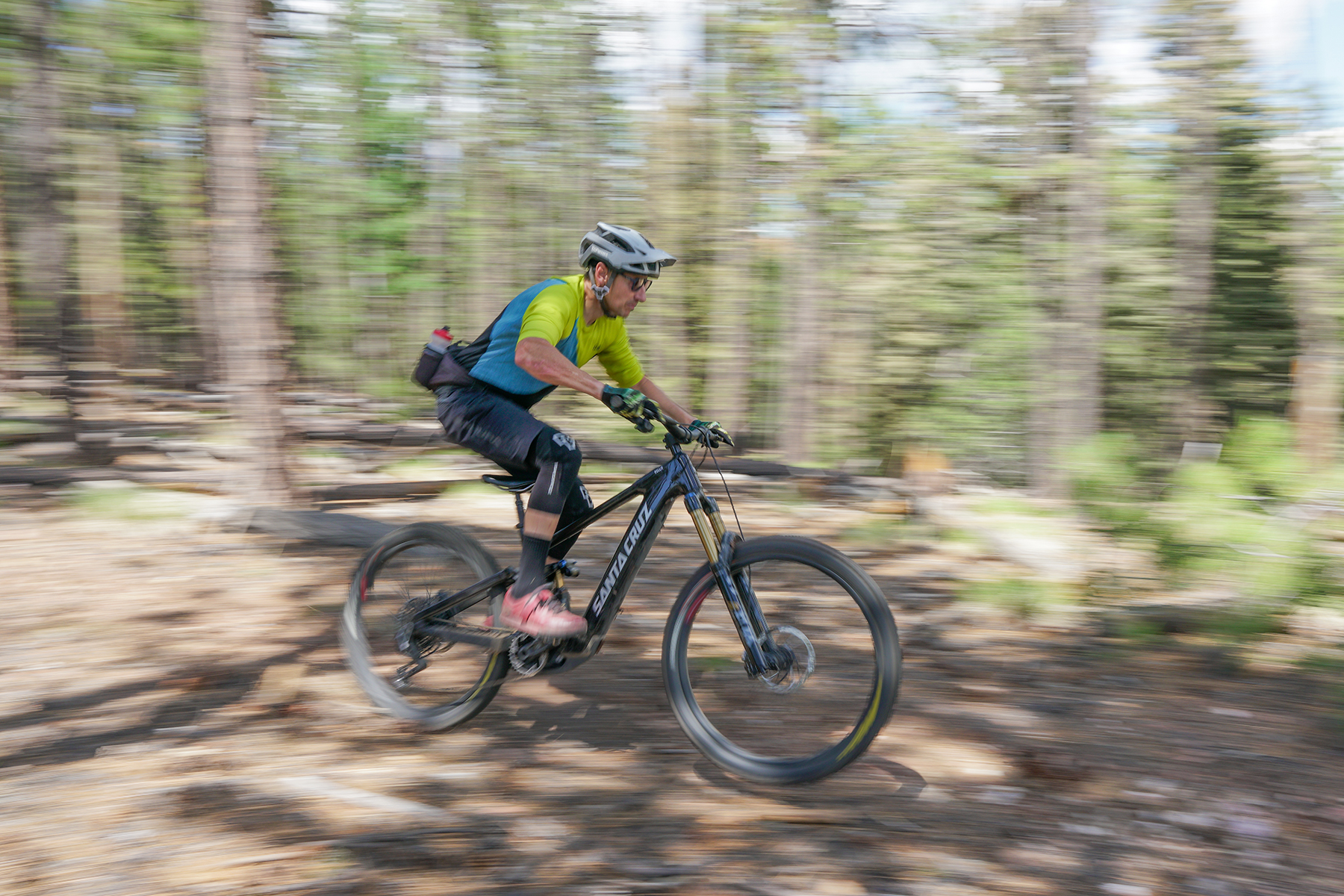
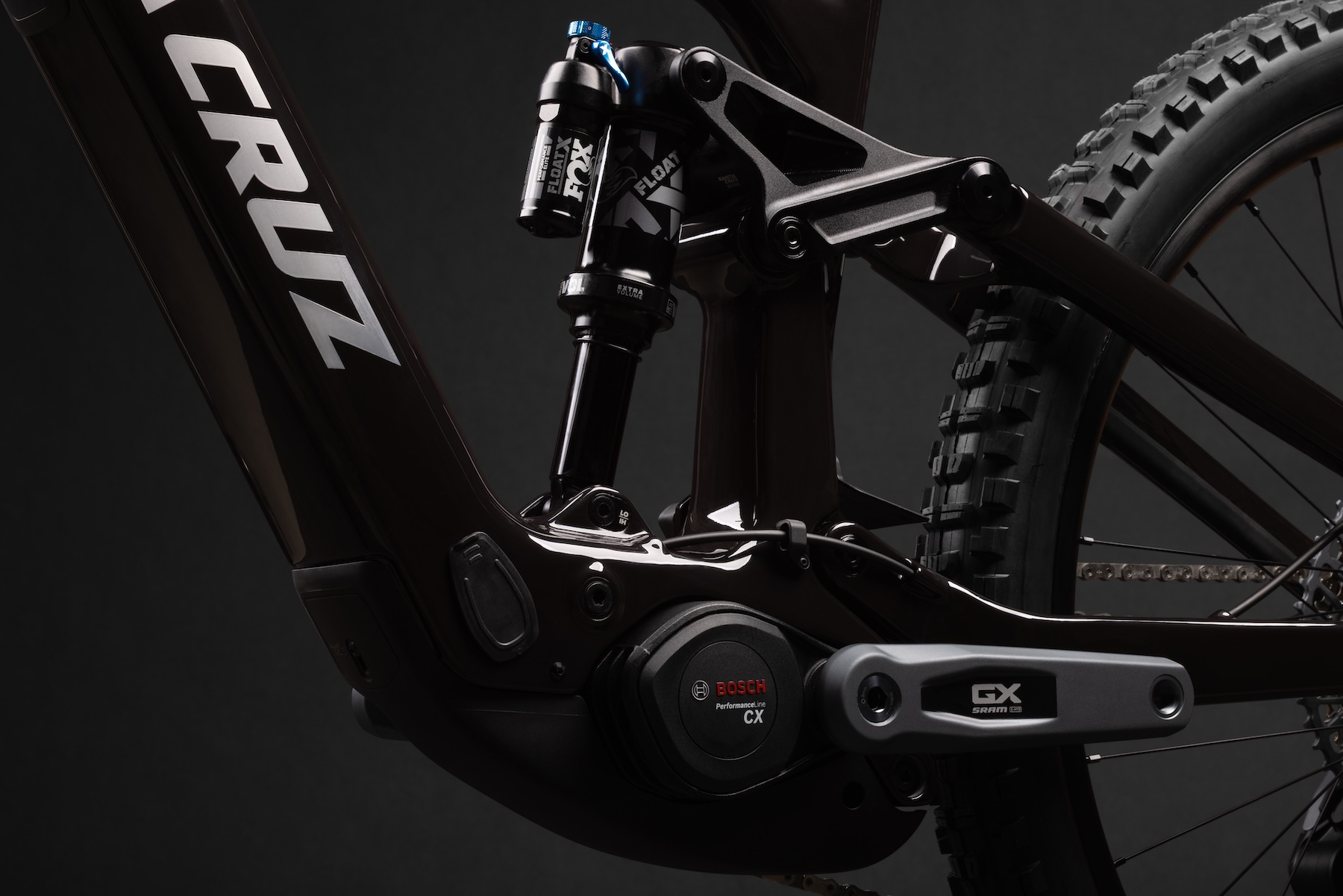
As with the Vala, different spec levels for the Bullit get either C or CC-grade carbon fiber, CC being a bit lighter and reserved only for the top-spec build (more on that in the Builds section). The Bullit is also a mixed wheel-only bike, again like the Vala, and Santa Cruz is clear that they believe the mixed wheel arrangement offers better handling traits for eMTBs and their added mass.
The Bullit also gets the same high-quality hardware used with the Vala, which includes a geometry flip chip where the rocker link meets the seatstays, and the suspension progression can be adjusted between 26% and 29% via a flip chip at the lower shock mount.
Drive System
The latest fifth-generation Bosch CX motor and 600 Wh battery also carry over from the Vala to the new Bullit. The battery is fully enclosed in the downtube, and a 250 Wh PowerMore range extender can be purchased separately to allow for extra ride time.
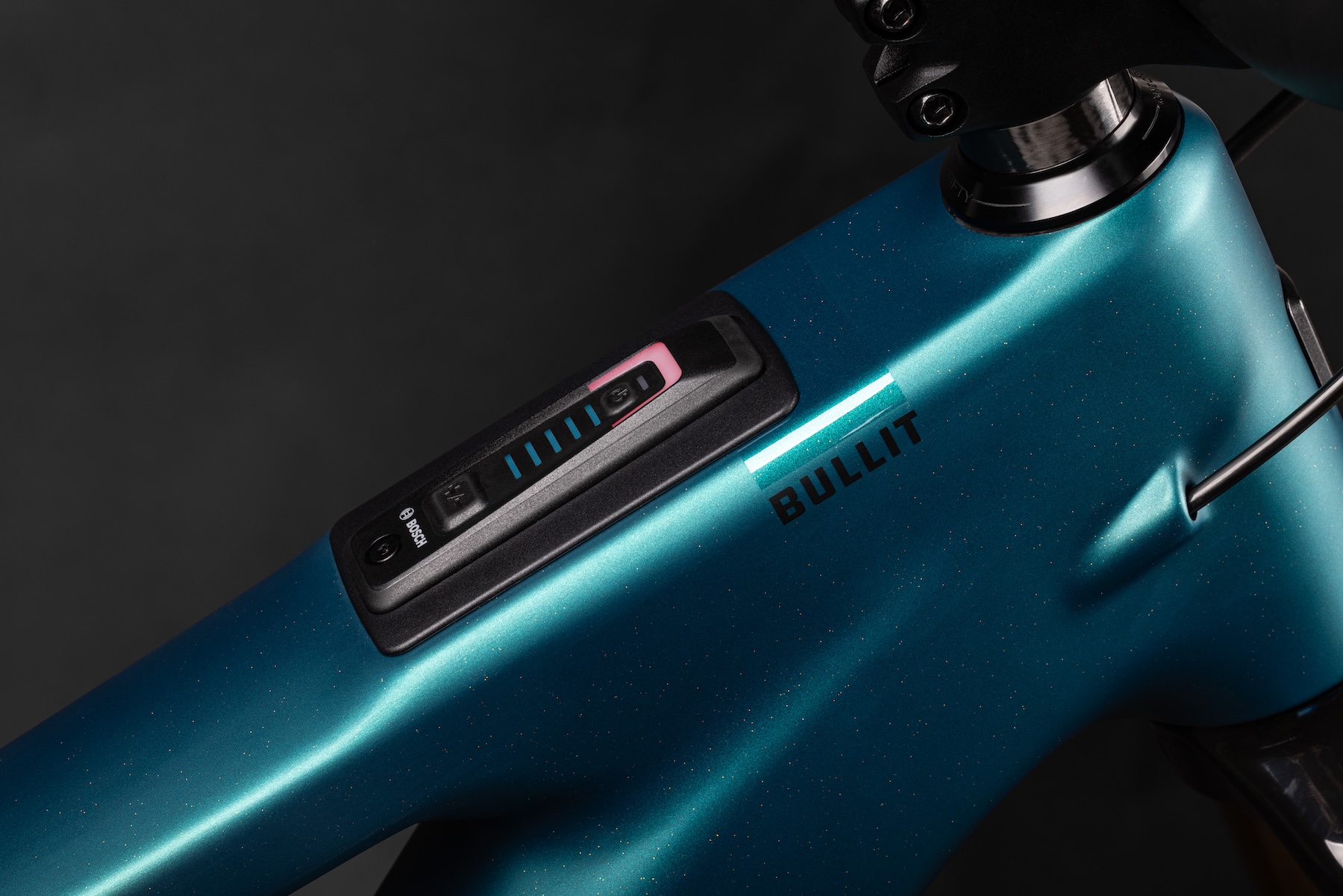
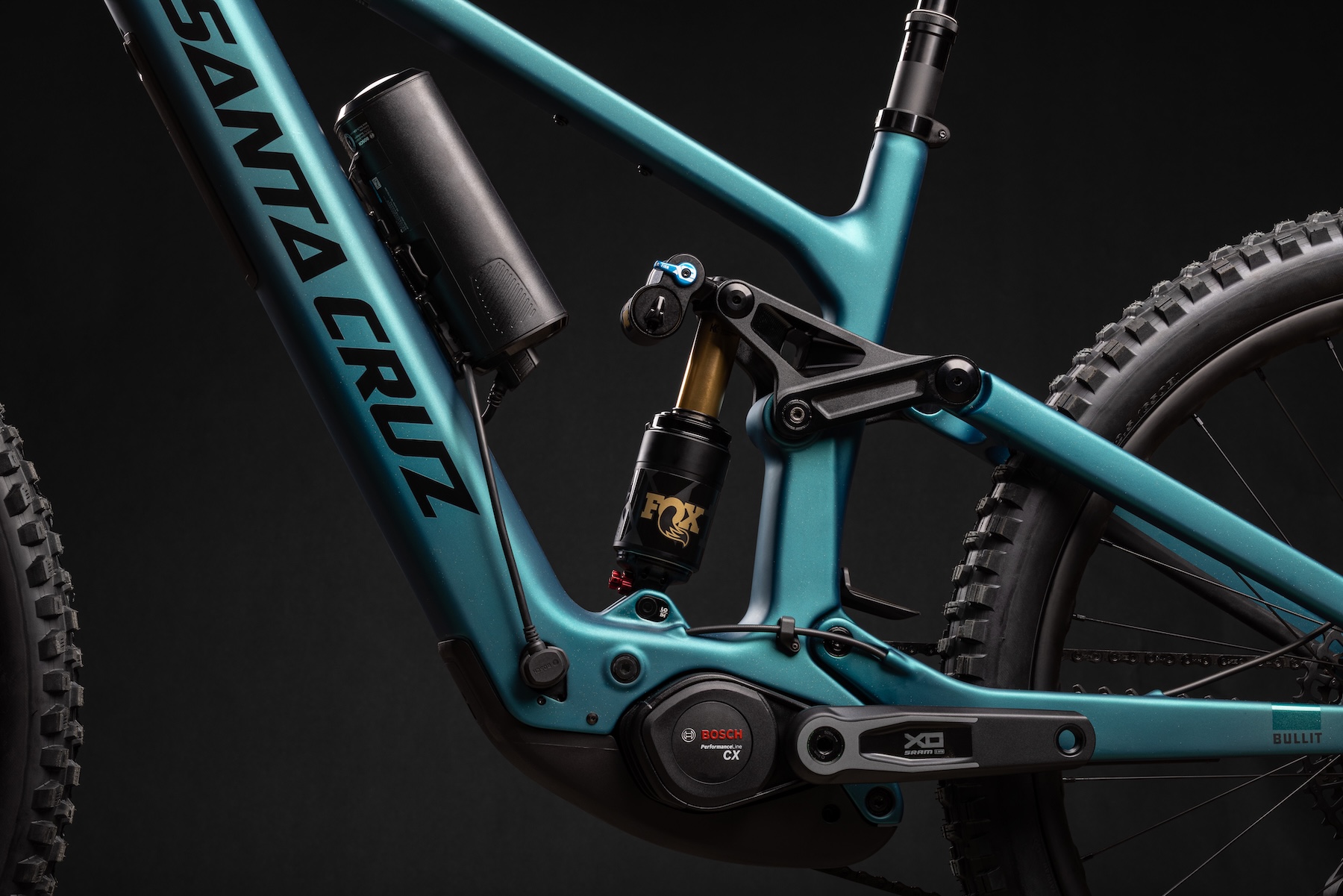
Fit & Geometry
We’ve talked a lot about the Bullit’s similarities to the Vala, but it starts to deviate a bit when it comes to geometry. Reflecting its aggressive intentions, the Bullit is rather slack at 63.6° in the high flip chip position, or 63.3° in low. In the case of a size Large, that slack head tube angle is mated to a 480 mm reach in the high setting, while the effective top tube length remains relatively compact for a Large at 617 mm thanks to a quite steep 78.7° effective seat tube angle. Shifting to the low position tightens up the reach slightly to 477 mm, while the effective seat tube angle drops slightly to 78.4°.
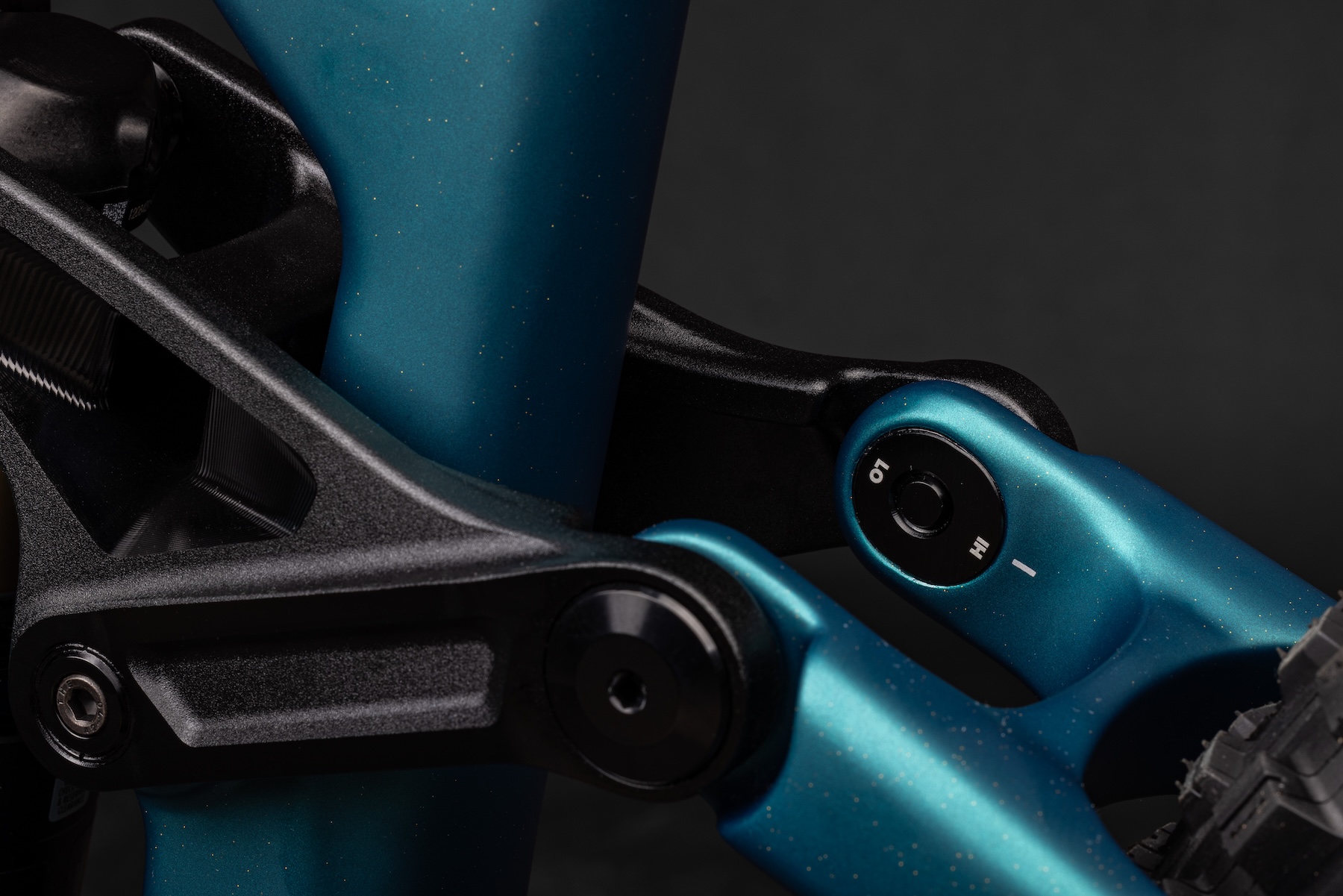
Chainstay lengths vary by size as a part of Santa Cruz’s proportional geometry concept, with approximately 3 mm between sizes. A Large gets 446 mm chainstays in the high flip chip setting, which changes very slightly to 447 mm in low.
The full geometry for the updated Bullit is below:
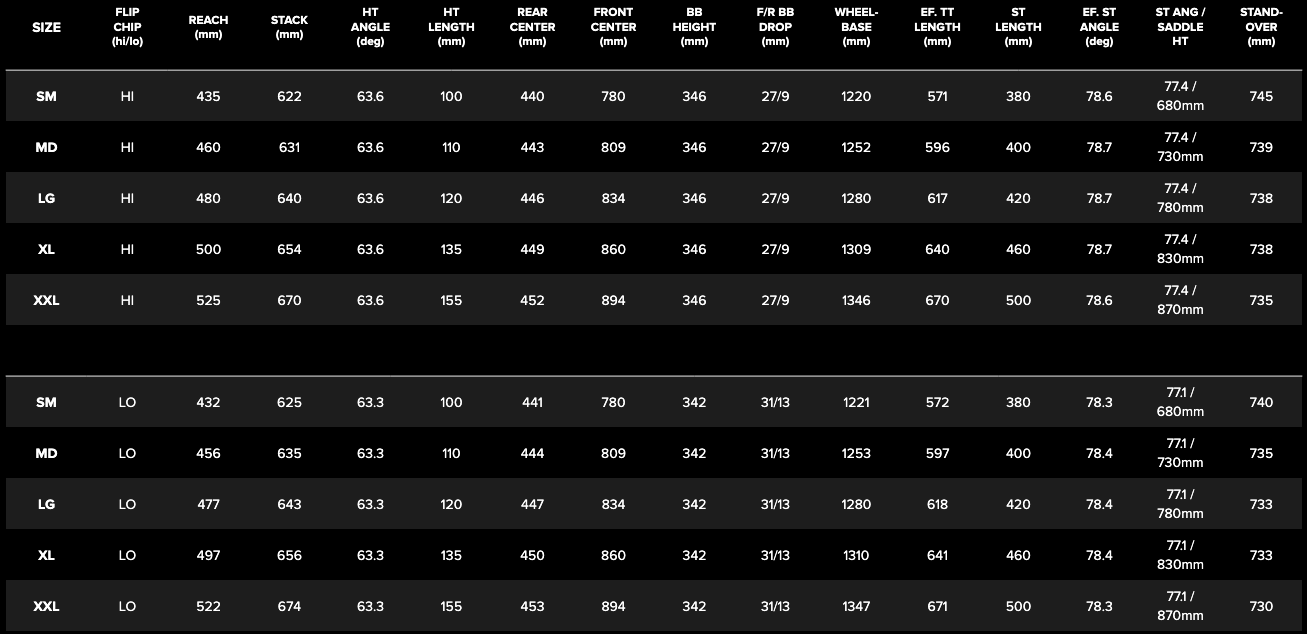
The Builds
Santa Cruz offers four builds for the Bullit, with the first three getting the C carbon frame, while the top step XO AXS RSV gets the higher-end CC construction.
All of the builds get SRAM brakes and shifting, with the base 70 build getting the new mechanical Eagle 70 Transmission and DB8 brakes, while the 90 build is next in line with Eagle 90 Transmission and Maven Base brakes. Shifting goes electronic for the next two builds, with the GX AXS build getting GX Transmission shifting, along with Maven Bronze brakes. The top-end XO AXS RSV has XO Transmission matched to Maven Silver brakes. Rotors are 200 mm front and rear on every build except the 70, which gets a 220 mm front rotor for the slightly less powerful DB8 brakes, and all get Maxxis DoubleDown tires, reflecting the Bullit’s descending-oriented intentions.
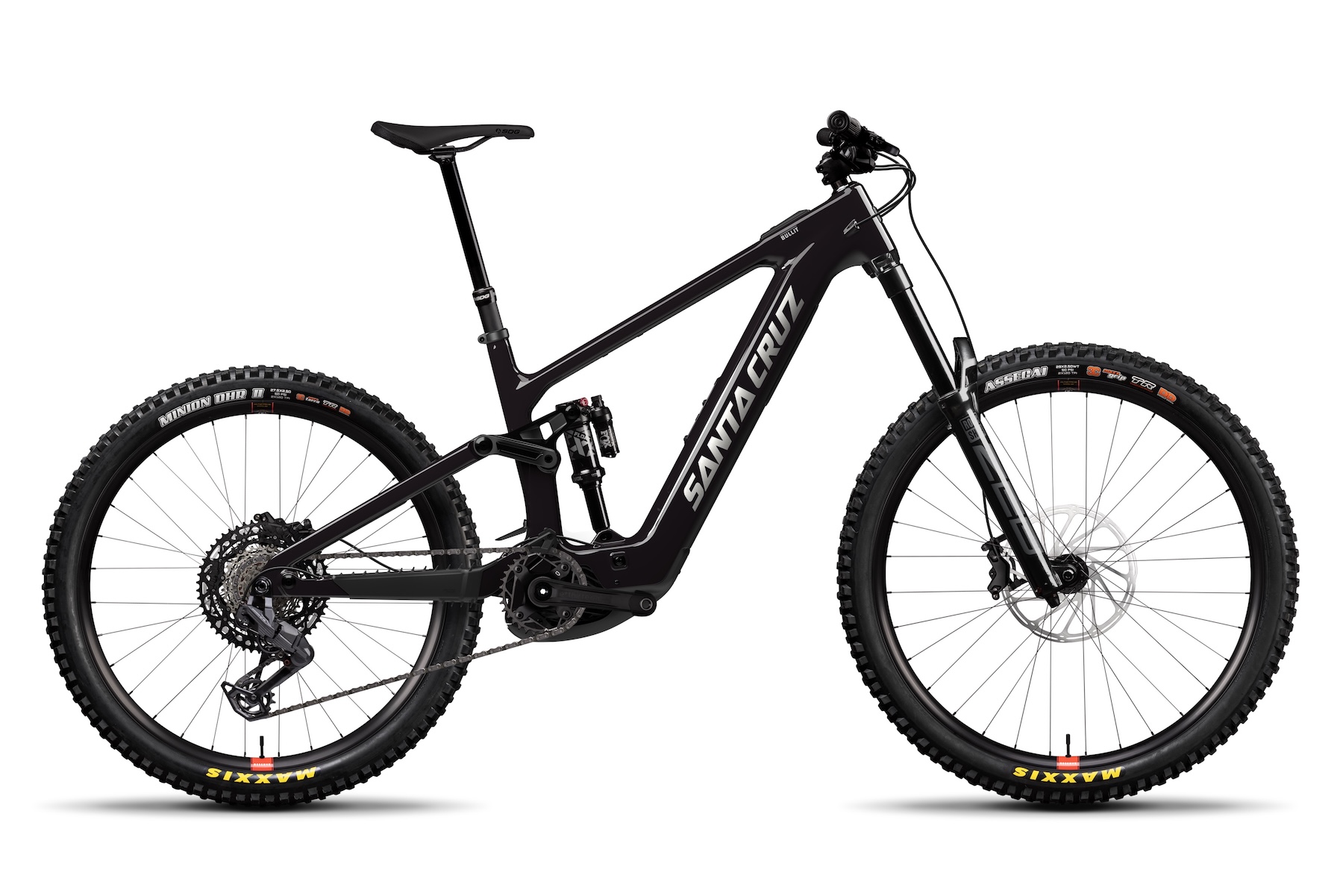
Despite being a rather aggressive eMTB, the 70, 90, and GX AXS builds of the Bullit all get Fox’s Float X rear shock; it’s not until the XO AXS RSV that we see Fox’s updated X2 in the spec. Only the 70 sees a RockShox fork in the form of the Zeb Base, while the rest get different tiers of the Fox 38. Wheels are provided by Santa Cruz’s affiliated Reserve brand, and all are built around 30 HD aluminum rims up until the XO AXS RSV, which gets a 30 HD carbon rim up front and a 30 DH carbon rim out back.
Despite proper tires and beefy brakes, all of the Bullit builds come in under 50 lbs / 22.68 kg, with the heaviest being the 70 build at a claimed 49.56 lbs / 22.48 kg. The XO AXS RSV will lighten your wallet the most, and it’s also the lightest build at a claimed 48.4 lbs / 21.95 kg. We’ll, of course, have to validate the weights once we have a chance to test one, but it’s great to see even burlier eMTBs dropping lots of weight from where they were just a year or two ago.
The full build details are as follows:
- Drivetrain: SRAM Eagle 70 Transmission
- Brakes: SRAM DB8 (220 mm front / 200 mm rear Centerline rotors)
- Fork: RockShox Zeb Base (170 mm)
- Shock: Fox Float X Performance
- Wheels: Reserve 30 HD AL6061 rims, SRAM MTH 716/746 hubs
- Dropper post: SDG Tellis
- Drivetrain: SRAM Eagle 90 Transmission
- Brakes: SRAM Maven Base (200 mm HS2 rotors)
- Fork: Fox 38 Performance (170 mm)
- Shock: Fox Float X Performance
- Wheels: Reserve 30 HD AL6061 rims, e13 SL E-Spec hubs
- Dropper post: OneUp V3
- Drivetrain: SRAM GX Transmission
- Brakes: SRAM Maven Bronze (200 mm HS2 rotors)
- Fork: Fox 38 Performance Elite Grip X2 (170 mm)
- Shock: Fox Float X Performance Elite
- Wheels: Reserve 30 HD AL6069 rims, e13 SL E-Spec hubs
- Dropper post: OneUp V3
- Drivetrain: SRAM XO Transmission
- Brakes: SRAM Maven Silver (200 mm HS2 rotors)
- Fork: Fox 38 Factory Grip X2 (170 mm)
- Shock: Fox Float X2 Factory
- Wheels: Reserve 30 HD carbon front / 30 DH carbon rear rims, DT Swiss 350 DEG hubs
- Dropper post: OneUp V3
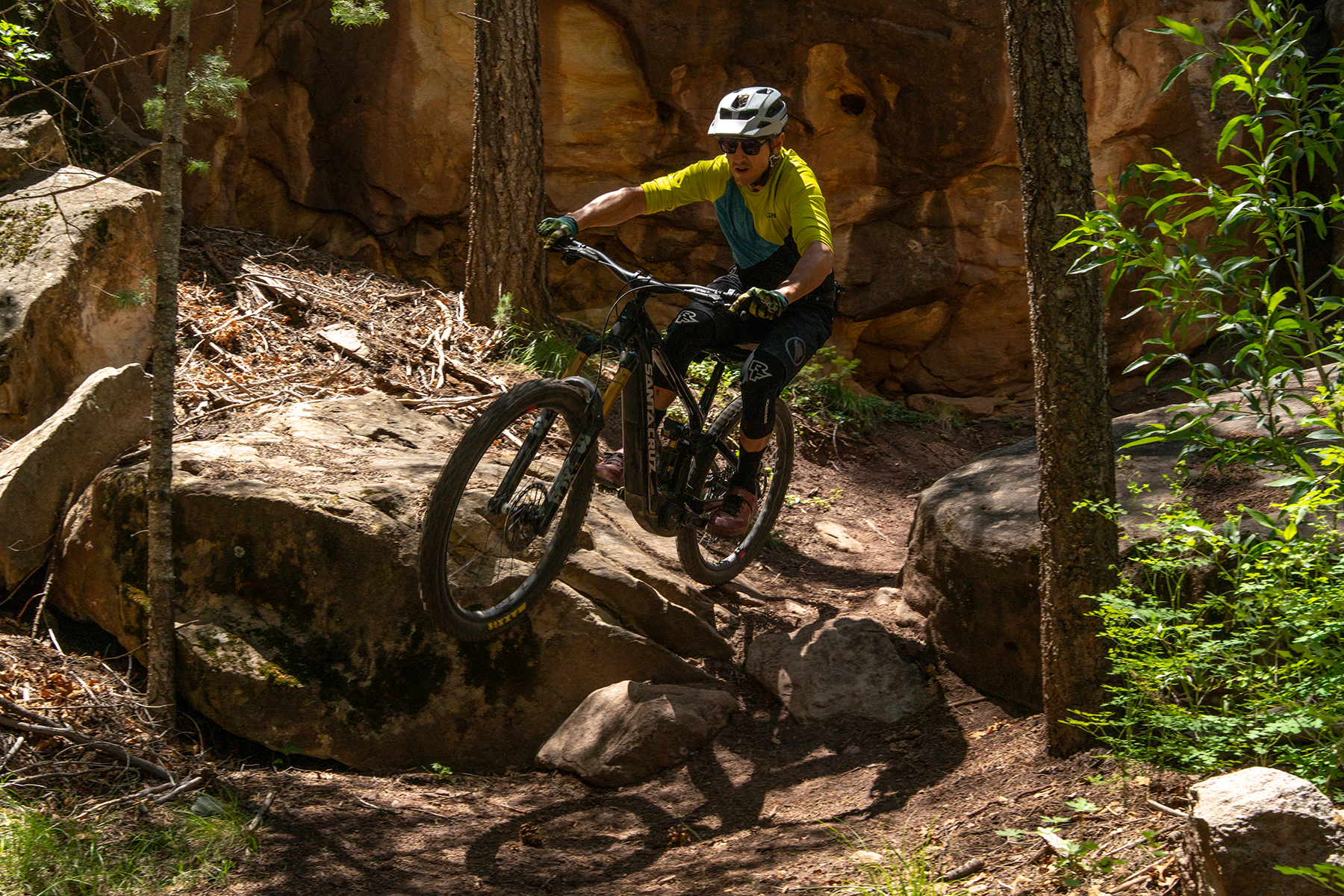
Full Review
Santa Cruz surprised us with a new Horst Link suspension layout for the Vala, which turned out to be quite good. And overall, we gave the Vala high praise for its agility, playfulness, and all-around capability, ranking it high on the list for Trail eMTBs.
Shortly after, they introduced the Bullit, which bears a close family resemblance to the Vala, and uses the same Bosch CX drive system and a similar suspension layout, but tweaks the recipe for more travel and a downhill focus.
We were able to get some overlapping time with the Vala and Bullit, and initially, I found the Bullit to be less engaging and agile, while also a little slower on more mundane trails. But the more time I on spent on the Bullit, the more I started to click with it and ride with more confidence and aggression — and wow does it come alive in a fantastically rewarding way. Let’s dig in to find out why I’m challenging Santa Cruz’s position that the Bullit is just a Downhill bike with a motor, and selecting it as my top choice for a full-power all-around eMTB.
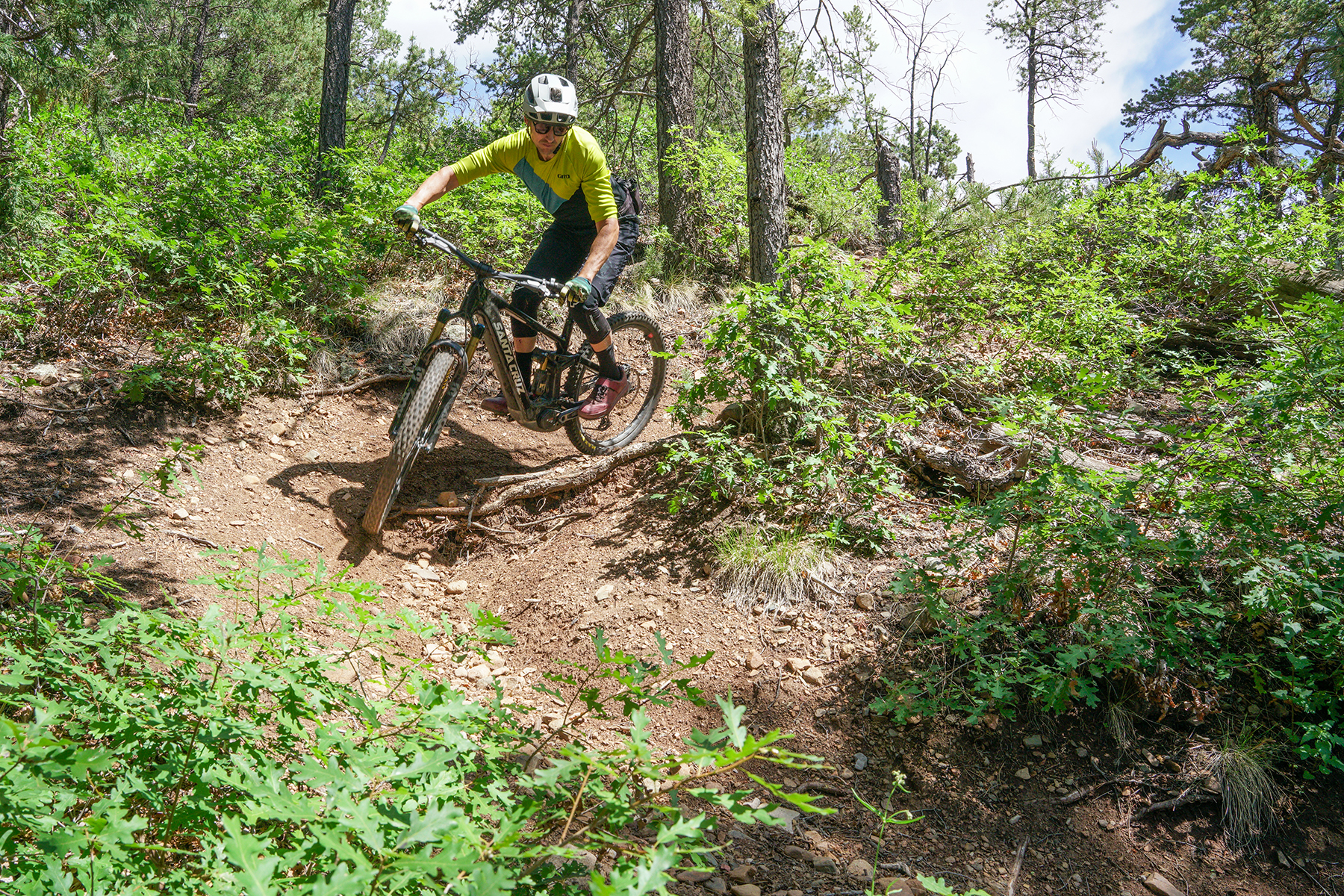
Fit & Sizing
Simon Stewart (6’, 170 lbs / 183 cm, 77 kg): Out of the box, the size Large Bullit has a similar fit to the Vala, which was a near-perfect match for me. And like the Vala, I didn’t have to swap in any parts to dial in the cockpit.
Doing a side-by-side comparison of them in the geometry charts, the numbers line up in an expected way. The Bullit has the same reach, but with a slacker head tube angle, steeper seat tube angle, and longer chainstays – all somewhat predictable changes when increasing travel.
Out on the trail, I got along well with the fit while climbing in the seated and standing positions, as well as riding undulating terrain, and bombing downhill. The Bullit shipped in the High geometry position, which put the effective seat tube angle at 78.7º, which is on the steeper end of the spectrum for my preferences. I often find that seat tube angles around 78.5º and higher can feel a bit too steep when you’re not climbing. On the Bullit, however, the steepness was mitigated by the 170 mm of travel and corresponding increased sag measurement. As such, I find the seat tube angle to feel only a touch steeper than the Vala’s, which is a degree slacker on paper.
The Bullit does feel more compact than the Vala, but there’s not much in it, and it’s definitely not cramped for my taste, allowing ample room to move around when climbing and descending. Overall, I think the fit matches the Bullit’s rowdy intentions, and the size Large is undoubtedly the right size for me. However, I’d be curious how David Golay, our Bike Editor up in the PNW, would feel about the fit. We are the same height (6 ft), which falls squarely within Santa Cruz’s sizing band for the Large. However, he favors a longer reach than I do, and he rides on steeper terrain. My guess is he would be tempted to try the XL.
[David: I’m not 100% sure which way I’d go here. For a non-motorized Enduro bike, the XL does look closer to my typical preferences. But especially as someone who doesn’t spend that much time on eMTBs, I tend to find the added weight to feel like a lot to manage when trying to ride more actively and dynamically, and sizing down can help there.]
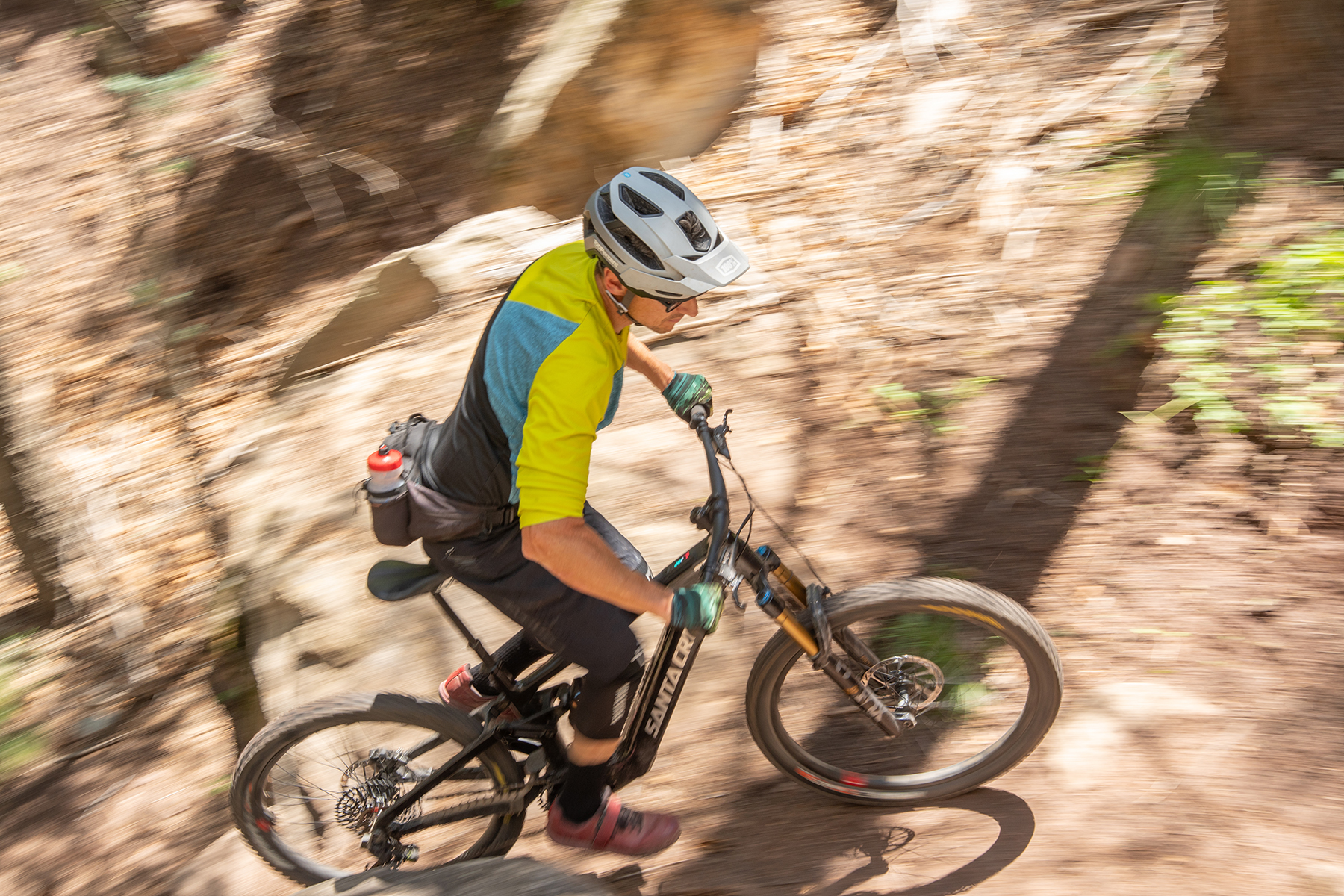
Climbing
Simon: I thought the Bullit might be a bit of a handful on some of my benchmark climbs, given the 170 mm of front and rear travel and slack 63.6º head angle (High geometry position), but after a few rides on some less technical climbs, I started to question that assumption. Often, the combination of long travel, slack head tube angle, and full power can create quite a busy climbing situation that can be tricky to manage, but the Bullit kept surprising me with clean runs up many of my fairly tricky warm-up sections.
I decided not to muck about and put it right to the test on the most difficult climb I use for testing, and coincidentally, the only eMTB to have a clean bottom-to-top run on this particular climb is the Bullit’s stablemate, the Santa Cruz Vala. Unexpectedly, the Bullit matched the Vala with an impressively smooth, no-dab, and pretty much drama-free ascent, so let’s dissect why I think the Bullit did so well.
First off, Santa Cruz states the Bullit has the steepest seat tube angle and slackest head tube angle of any they’ve ever made that was meant to be pedaled. I believe both are factors in the Bullit’s climbing performance.
I mentioned in the Flash Review that it was interesting that the Bullit shipped in the High geometry and Low progression settings, which is opposite to the way Vala shipped. I think Santa Cruz was wise to do it that way because it feels more versatile in those settings, and I prefer climbing on the Bullit with it in the High geometry position. Actually, I ended up preferring the High position for descending as well; more on that later.
In the High position, the effective seat tube angle is a quite steep 78.7º, which I think plays a big part in the Bullit’s solid climbing performance — it keeps a good amount of weight on the front wheel, while also putting the rider in an efficient pedaling position. I know that being efficient may seem irrelevant on an eMTB, but on steep, nasty sections, I feel like I contribute just as much power as I would on a non-powered bike, and with as much travel as the Bullit has, I think it makes a difference. The High geometry setting also increases the bottom bracket by 4 mm — extra crank clearance is always welcome in the rocky, nasty terrain this climb is riddled with.
With the suspension in the Low progression setting (26%), it feels responsive and supportive, but it also doesn’t seem to lose much in the traction department either — which I thought it might. When I experimented with it in the High progression position (29%), which Santa Cruz claims “sits in a bit more and prioritizes bump-eating forgiveness”, I didn’t notice much more compliance, or any percviable increase in traction, but I did notice it was more affected by my abrupt weight shifts when tackling technical ledge moves.
The Bullit’s sub-48 lb weight helps make it less fatiguing to move around. Additionally, the smaller 600 Wh battery puts less weight in the downtube area, which also makes a difference when getting the front end up over rocks and ledges.
Another contributing factor is the Maxxis DHR II 3C Max Terra rear tire with the Double Down casing. I’m more comfortable running lower pressure with the DD casing than I am in lighter ones, which definitely helps with climbing traction.
Finally, the Bosch CX motor is a beauty, and has heaps of consistent, controllable power that gives you confidence to commit to challenging lines. This is from my Vala review because it applies equally to the Bullit:
“The CX motor’s overrun (Bosch refers to it as extended boost) is lovely in the way it keeps supplying power after you stop pedaling and made easy work of powered front wheel lifts up some pretty big ledges. I often found myself using half pedal strokes to keep the assist going through tricky tight sections where a full revolution of the cranks was not possible, again made possible by Bosch’s extended boost functionality”.
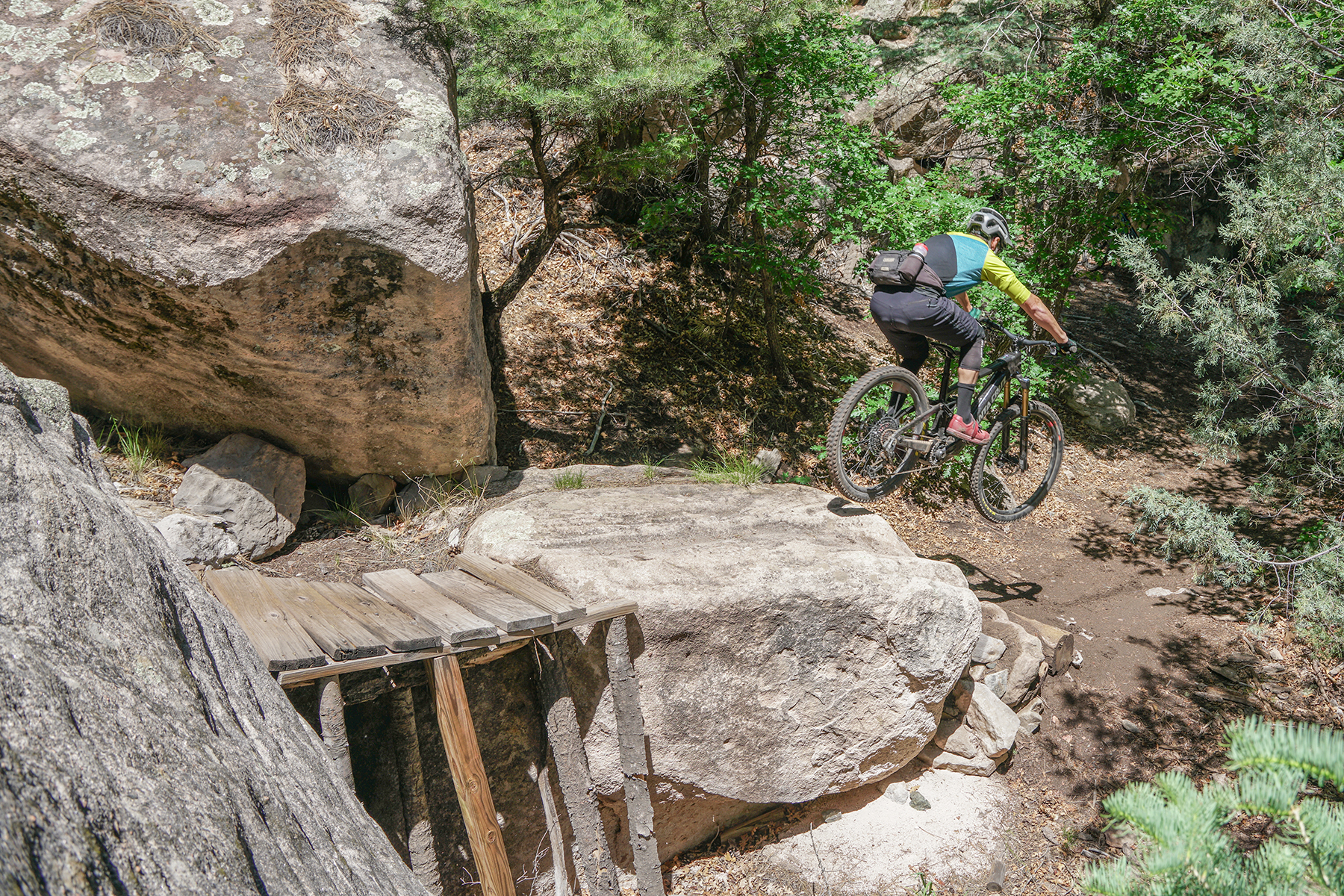
Descending
We’ve been making numerous comparisons to the Vala, and the similarities continue when descending. The Bullit takes many of the attributes we liked about the Vala and takes them up a notch or two, or three, when pointed downhill.
This isn’t surprising given the Bullit has more travel, a slacker head angle, and a decidedly more downhill focus than the Vala. The 170 mm of Horst Link rear travel coupled to the Fox Float X2 rear shock match up very well, and the Bullit excels in chunky, steep terrain, while also retaining much of the Vala’s playful nature.
As mentioned above, the Bullit shipped in the High geometry and Low progression settings, which ended up being my preference for climbing and descending. I find the High geometry setting has more impact on climbing performance due to the steeper seat tube angle, and I don’t feel that the slight difference in head tube angles (63.6º/63.3º) makes an appreciable difference in stability, even on the steepest, rowdiest trails. However, the steeper head angle in the High setting does seem to improve front wheel cornering bite a hair, which is noticeable and welcome.
In the Low progression setting, the Bullit feels a touch more responsive and lively, which suits my riding style and terrain preferences more than the High progression setting does. The suspension feels more active in the High setting and gives the Bullit a glued-down, ground-hugging feeling, which in certain situations is really nice, but overall my preference leans towards making the Bullit more responsive and lively because that taps into its playful side. Like I said, that aligns better with my riding style.
Either way, the independent geometry and progression flip chips are beneficial because even though the changes are subtle, they do allow riders to tweak the handling a bit to better suit their preferences.
I mentioned in the Vala review that historically, I’ve found a lot of Santa Cruz bikes to be more playful than game-on speed-focused race bikes. The Vala was added to the list of recently reviewed bikes, such as the Heckler SL and Bronson 5, that fit that description. Despite having more travel and an aggressive downhill focus, the Bullit is also added to that list. It loves to square off corners and manuals beautifully, and even though it has the capability to plow through chunky sections at high speed, I still found myself looking for more creative lines and places to pop off features.
Not surprisingly, the Bullit feels properly at home in the bike park, much in the same way the Mondraker Dune XR did, and it’s always fun to skip the lift lines and ride back up. The 600 Wh battery provides enough juice for plenty of laps, and I don’t feel the need to use the range extender since I prefer how the Bullit handles in fast, technical terrain without the extra weight. I’ve also mentioned my affinity towards mullet setups for eMTBs, and that is especially true in the bike park. I love how the Bullit corners on sculpted berms, and how comfortable it is on the back wheel. Currently, I can’t see a case where I would not opt for mixed-wheel-size eMTB.
Overall, the Bullit’s downhill performance is impressive, and the Horst link suspension manages the 170 mm of travel very well. It remained composed through everything I threw at it, while also having a cheeky, playful side.
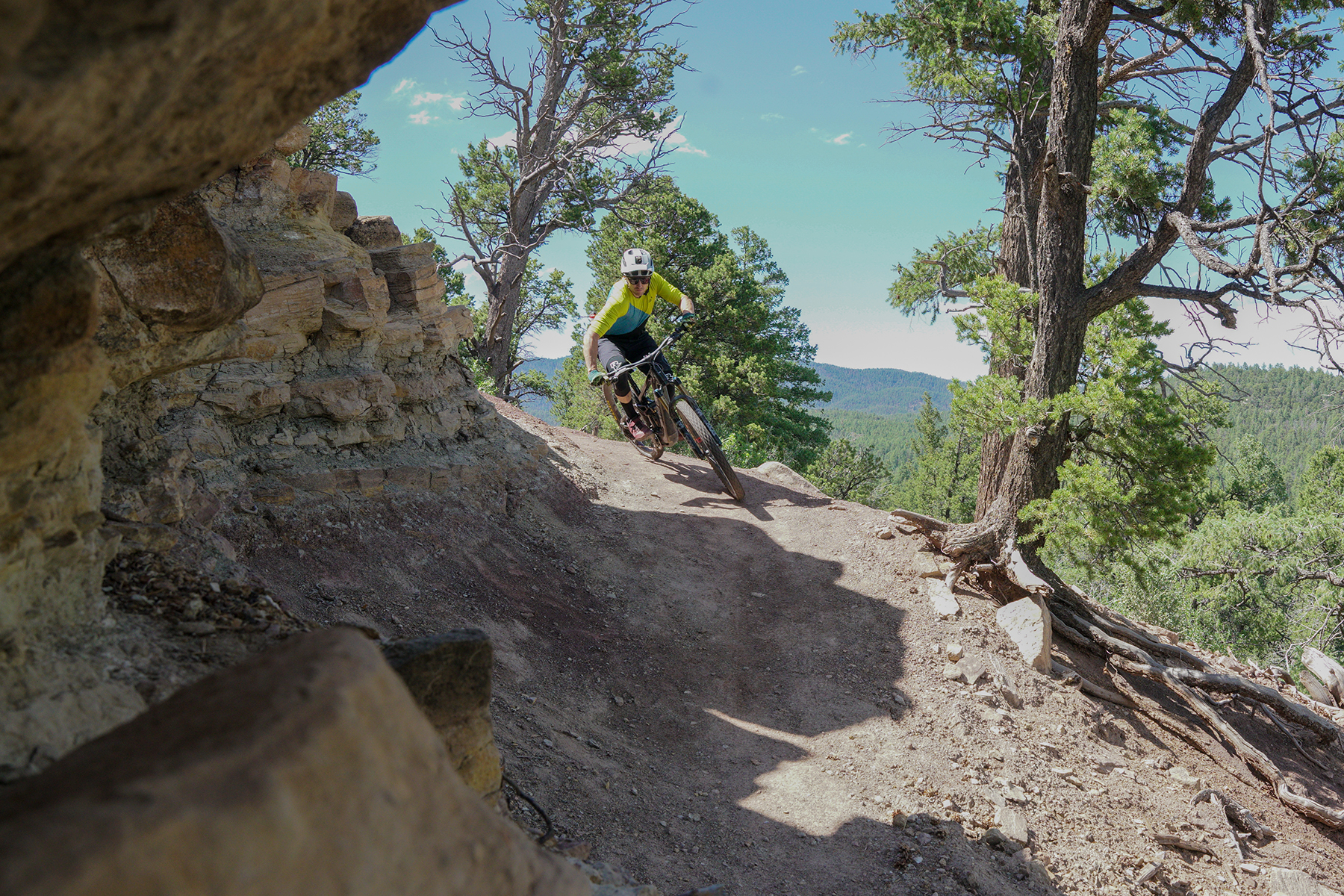
Drive System and Range
The Bullit comes equipped with the Gen 5 version of the Bosch CX drive system. We’ve spent a lot of time on it now and go into detail regarding the improvements made over the Gen 4 version in the Bosch CX Flash Review. Since receiving the Bullit, Bosch has also released a new performance software update, and we’ll go into detail on the new software in an upcoming udate to the CX story, so be sure to check that out.
Initially, Bosch left the power numbers of the Gen 5 CX motor the same as the Gen 4. Now that the performance software upgrade has been released, that makes sense. It seems that they built in the capacity to produce more power, but took a minute to dial in the software. I’ve said before that even with the same output as the Gen 4 motor (85 Nm of torque and 600 watts of power), the power of the Gen 5 motor feels a bit peppier.
That said, new drive systems from Specialized and DJI have been released with considerably higher numbers, so I wonder if Bosch was secretly waiting for them to publish their respective power numbers before finalizing the performance software upgrade so as to be more competitive. It’s also about more than just peak output numbers, because Bosch has done a really nice job of reducing noise, making it lighter, more resistant to heat-related power loss, and seemingly making it more efficient (based on my admittedly unscientifc range testing).
I’m a fan of Santa Cruz’s approach to battery size for both the Vala and Bullit. They spec the smaller of Bosch’s two available batteries (600 Wh vs. 800 Wh) to keep the weight down. The decision to go smaller may be polarizing to some, but the lighter battery has an undeniable positive effect on handling. Then factor in adding the optional 250 Wh Powermore range extender, and you can tailor the battery capacity as needed — less range and lighter weight for the majority of your rides, and then slap on the range extender and get considerably more range with only a 3.5 lb / 1.58 kg weight penalty.
The reason I like that approach is that most of the full-power eMTBs with bigger batteries that we have tested have weighed in the 50–53 lb / 22.7 – 24.0 kg range, and when I put the Bullit on the scale with the range extender installed, it still only weighed 51.5 lbs / 23.4 kg. Besides losing the ability to carry a water bottle in the frame when the range extender is installed, in my opinion, it’s a win.
On the reliability side, we’ve put a ton of miles on Bosch drive systems with no issues, and between the Bullit and Vala we have over 600 miles on the updated Gen 5 motor, again with no issues. Given my recent experiences with the latest Bosch CX drive system, and now with the potential to add more power with the software upgrade, the CX gets my vote for the motor I prefer in eMTBs. But we have been spending time on the new Specialized 3.1 motor in the Turbo Levo 4, which so far is shaping up to be quite competitive, and we hope to get on an eMTB with the DJI Avinox motor soon, so that could change.
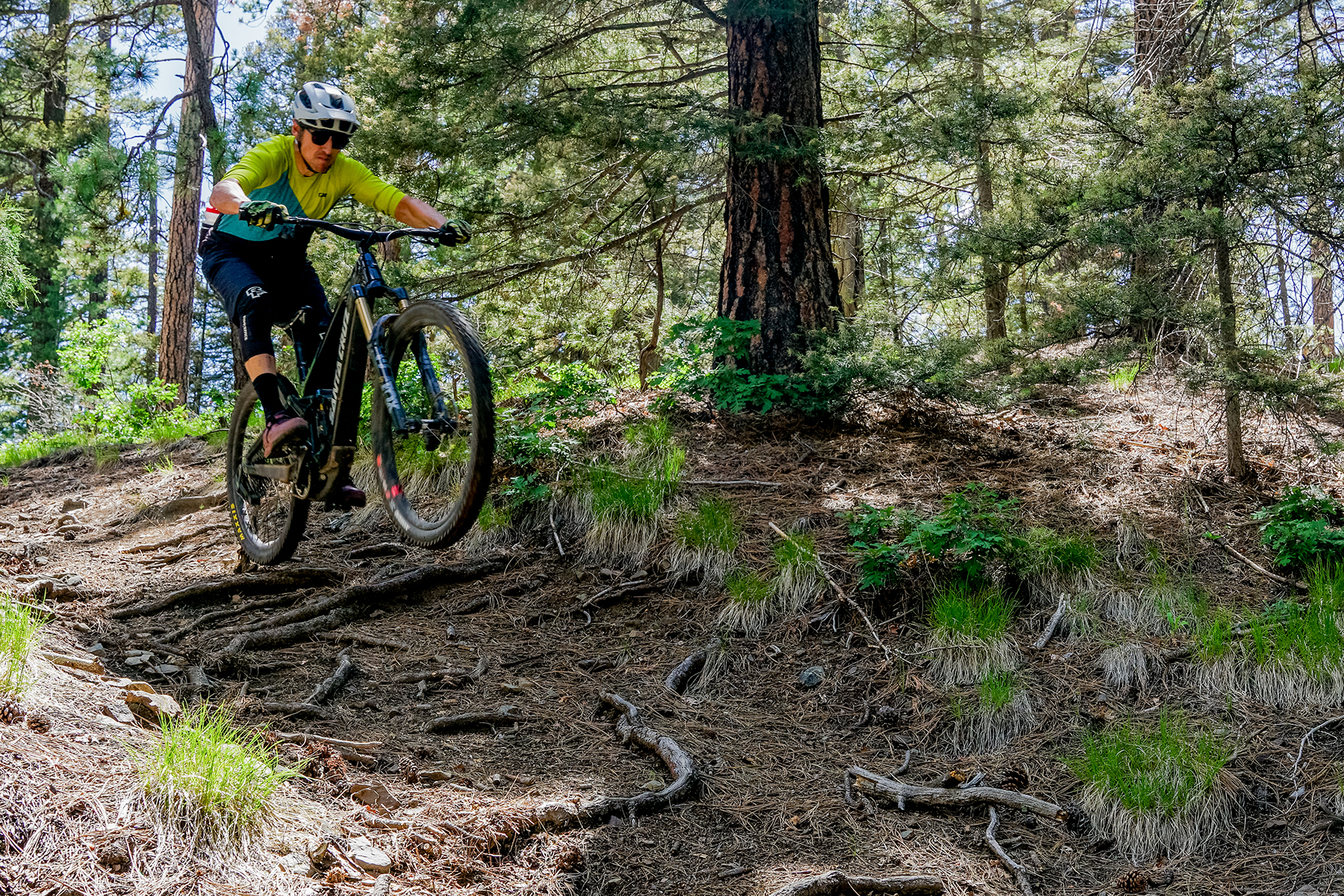
The Build
We received the Bullit in the XO AXS Reserve build, which is the top-tier build for the Bullit. At $12,500, it is an expensive bike, but it is a very well thought-out build with nothing I feel needs upgrading.
I like Santa Cruz’s decision to spec the Double Down casing on the Maxxis DHR II and Assegai tire combo. I hadn’t been spending much time on Maxxis tires with that casing up until the Bullit arrived, and I was reminded how nice it is to have burly casings, especially on a bike that is as talented going downhill as the Bullit.
I’ve mentioned my affinity for SRAM’s Maven brakes a few times already, but it’s worth mentioning again that I think they are a particularly good fit for eMTBs. The Maven Silvers did a fantastic job consistently slowing down an aggressively fast 48 lb bike.
Overall, I think Santa Cruz does a nice job spec’ing their bikes, and the XO AXS Reserve build on the Bullit is no exception since it’s pretty much how I would build it myself. Perhaps I’d be tempted to try different wheels, but I would need to remind myself that I’ve also never broken any Reserve carbon wheels, and if I did, they would likely be replaced under warranty. To be clear, I like the Carbon Reserve wheels on the Bullit, and the only reason I would choose different ones would be to simply try another brand’s wheels I’m interested in.
Other component highlights include the OneUp dropper post, SRAM XO Transmission, and Fox Factory suspension.
One note on the build is to be careful when installing a bottle cage or the range extender, as there are multiple mounting locations on the downtube. If you use the lower mounting holes, there’s a good chance of interference with the cage or range extender and the FOX X2’s reservoir when compressing the suspension.
Santa Cruz also offers free bearing replacement to the original owner, and the frame carries a lifetime warranty.
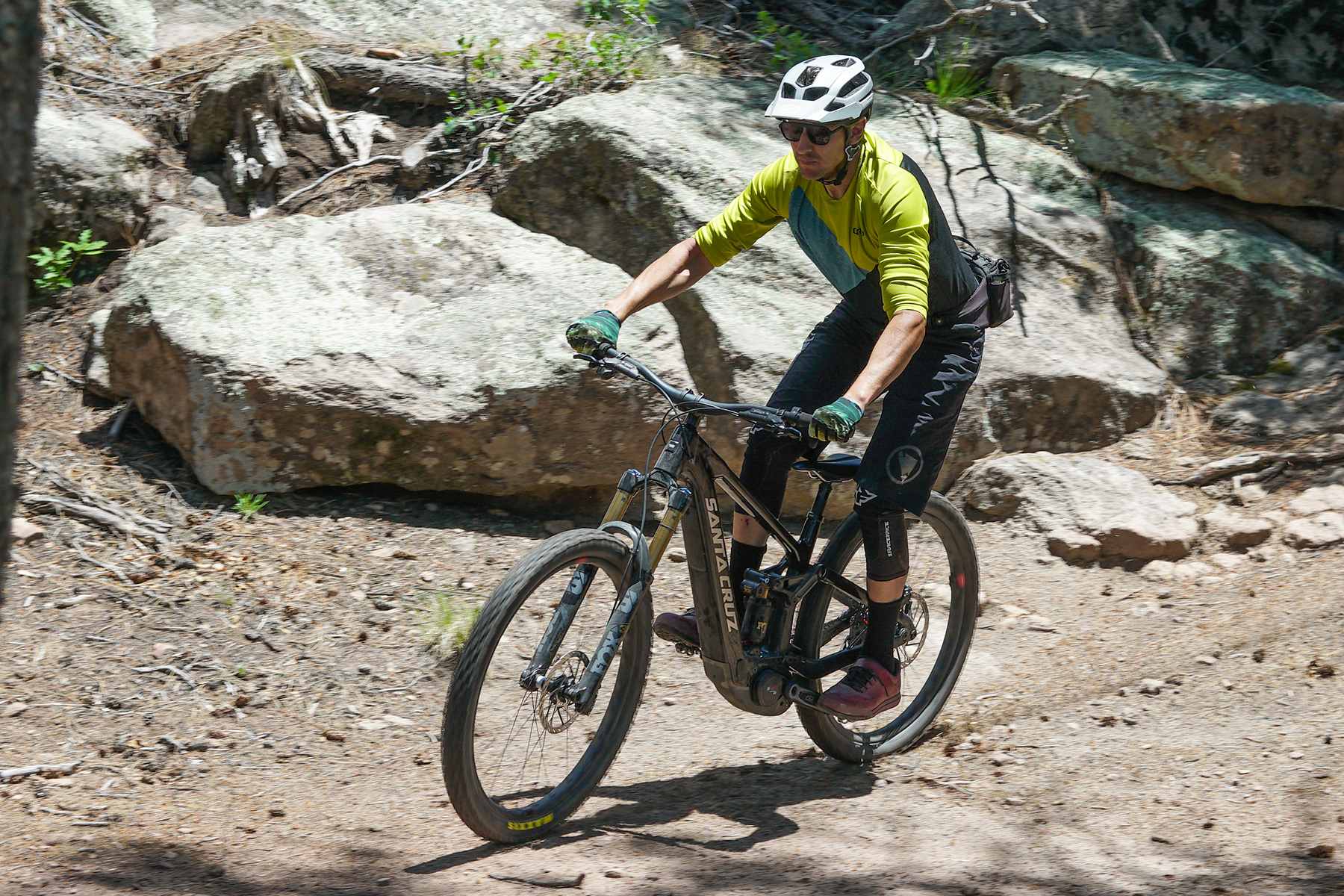
Who’s It For?
My own preferences for an eMTB have consistently been in the upper travel range of the Trail eMTB category, usually with around 150-160 mm of rear travel. But the Bullit has me questioning that, and for the moment, I’m team long-travel eMTB, and the Bullit is at the top of my list. Sure, it is slightly less engaging at slower speeds on more mundane trails, but what it can do when you open it up on rowdy trails is so rewarding that I’m 100% ok with sacrificing a tiny bit on the other end. And while it responds amazingly well to an aggressive riding style, it’s not a bike that demands you be game-on all the time.
So, with that said, I think the Bullit deserves consideration for all types of riders who are looking at full-power eMTBs, and especially for those for whom always having enough bike for nearly every situation sounds appealing.
Add in the range extender, and the Bullit becomes a versatile option for long adventure rides, especially ones that end with bitchin’ descents.
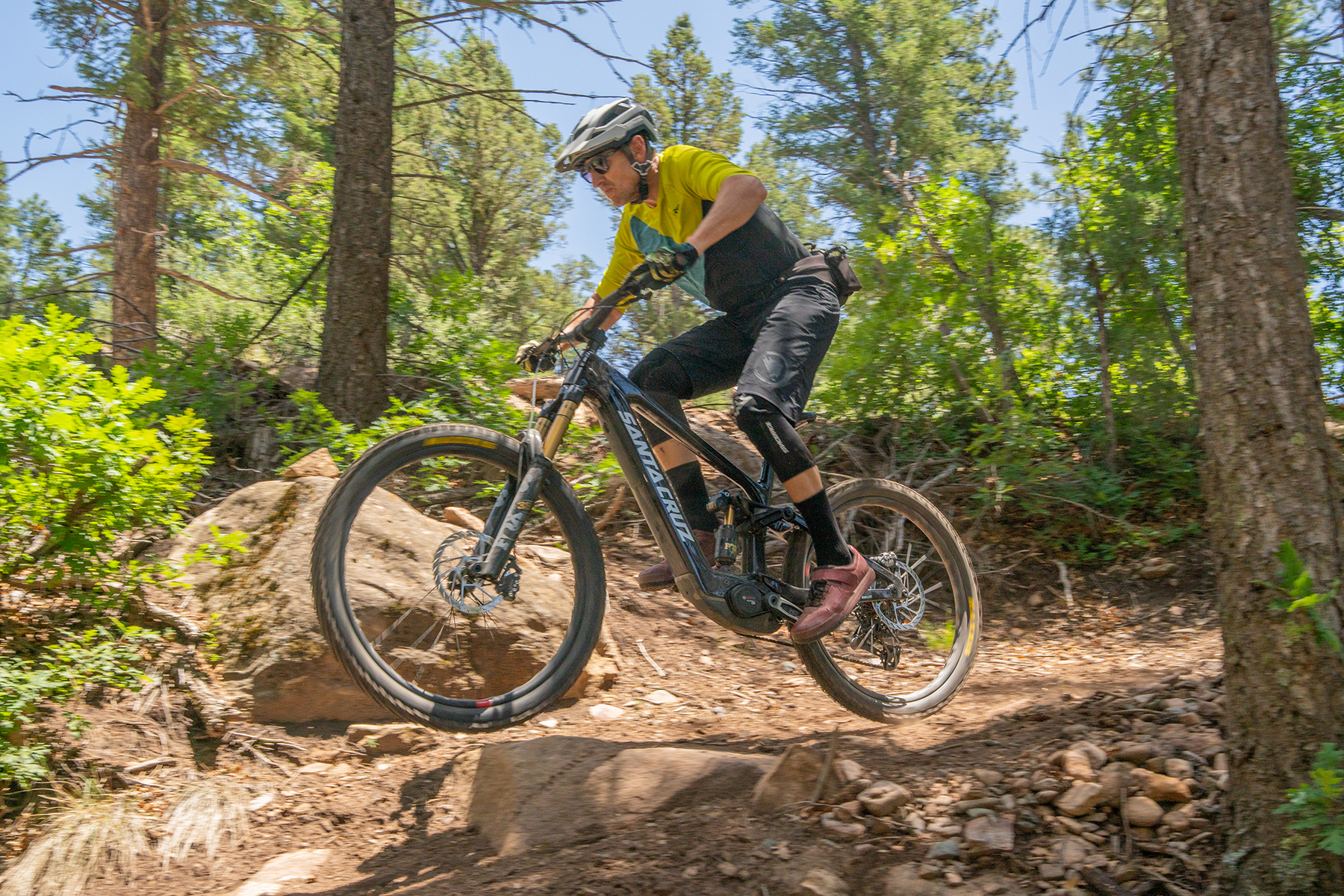
Bottom Line
Despite very much having a downhill focus, and Santa Cruz describing it as a “Downhill bike with a built-in chairlift”, I found the Bullit to be surprisingly well-rounded and is equally at home at the bike park, taking on big adventure rides (with the range extender of course), hot lapping my local trails, or tackling challenging climbs.
I wasn’t expecting to prefer the Bullit over the Vala, and my first ride left me a wee bit underwhelmed. But the more I rode it, the more that opinion changed. Fast forward to today, and given the choice between them, I would choose the Bullit – the sacrifices made for the massive amount of capability aren’t that compelling, making the Bullit the ideal answer to the question of why not have all the travel if you have a motor.
Deep Dive Comparisons
BLISTER+ members and those who purchase our Digital Access Pass can check out our Deep Dive comparisons linked below. Get our Digital Access Pass to view all our Deep Dives and Flash Reviews, or become a BLISTER+ member today to get access to that and a LOT more, including the best worldwide Outdoor Injury Insurance, exclusive deals and discounts on skis, personalized gear recommendations from us, and much more.

Deep Dive: Santa Cruz Bullit 4
We compare the Santa Cruz Bullit to the Cannondale Moterra SL, Trek Slash+, Mondraker Dune XR, Devinci E-Troy, and Orbea Wild.
Blister’s Flash Reviews and Deep Dives are accessible to those who purchase one of our paid subscriptions
To get our comprehensive Deep Dives and our initial, unfiltered reports on new gear, become a member and receive many other services, deals, and discounts.
If you’re already an active member, please log in.
(If you’re already logged in and a member in good standing and seeing this message in error, please refresh this page in your browser.)

Interesting regarding the Less/More progression setting ride feel. I put my Vala’s in More from day 1 because I want my bikes to have a bottomless feel (and hated the super linear suspension on my Levo). But I prefer my Nomad’s High setting (which is also less progressive), so I guess I should try out the Less on the Vala.
A lot of Vala owners run a 65mm stroke shock on them to get ~160mm rear travel, which sort of splits the difference between the stock Vala and Bullit. I did that coupled with less sag, so that it still feels energetic off the top but has a bit deeper reserve for heavy landings.